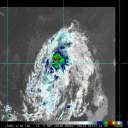Show Selection:
|
#904247 (Received by flhurricane at: 4:58 AM 23.Sep.2017)
TCDAT4
Tropical Storm Lee Discussion Number 20
NWS National Hurricane Center Miami FL AL142017
500 AM AST Sat Sep 23 2017
Not much has changed with Lee over the past six hours. The
convection previously observed in the SE quadrant appears to have
rotated around the tropical storm and faded, but a 0609 UTC SSMI
overpass indicates that a new burst has since taken its place.
Dvorak intensity estimates range from 30 to 35 kt, so the intensity
has been held at 35 kt for this advisory.
Every aspect of the forecast is highly uncertain. With regards to
intensity, the model forecasts range from dissipation (GFS) to
a category 2 or 3 hurricane (HWRF, HMON). Since the environment
still appears to be generally favorable for intensification, my
forecast remains close to the HWRF, and a little above the intensity
consensus through 72 h. The forecast shows gradual weakening after
that time as the shear increases. Because Lee is so small, it is
very possible that the tropical storm could strengthen far more
quickly than indicated here, at just about any time during the
forecast period. Likewise, rapid weakening could occur later in the
period if the shear increases like the SHIPS diagnostics indicate it
will.
As uncertain as the intensity forecast is, the track forecast may be
even more so. The ECMWF now shows a relatively deep Lee drifting
south for the next 72 hours, followed by a gradual turn toward the
northwest. On the other hand, the GFS continues to depict a shallow
Lee (or its remnants) moving steadily eastward through the forecast
period. As a result, these two typically reliable models differ by
more than 900 miles at day 5. The new official track forecast is
generally close to the corrected consensus models, FSSE and HCCA,
but hedges somewhat toward the ECMWF since it's version of Lee is
more in line with the NHC intensity forecast. As a result, the NHC
track forecast has been shifted significantly to the west,
especially at 72 h and beyond, but still lies nearly 400 miles to
the east of the ECMWF.
Needless to say, confidence in the forecast is low, and significant
changes to the track or intensity forecast may be required during
the next day or two.
FORECAST POSITIONS AND MAX WINDS
INIT 23/0900Z 31.9N 49.2W 35 KT 40 MPH
12H 23/1800Z 32.3N 49.1W 40 KT 45 MPH
24H 24/0600Z 32.5N 48.4W 45 KT 50 MPH
36H 24/1800Z 32.2N 47.4W 50 KT 60 MPH
48H 25/0600Z 31.7N 46.2W 60 KT 70 MPH
72H 26/0600Z 30.5N 44.5W 75 KT 85 MPH
96H 27/0600Z 29.8N 45.0W 70 KT 80 MPH
120H 28/0600Z 30.5N 46.5W 60 KT 70 MPH
$$
Forecaster Zelinsky |



